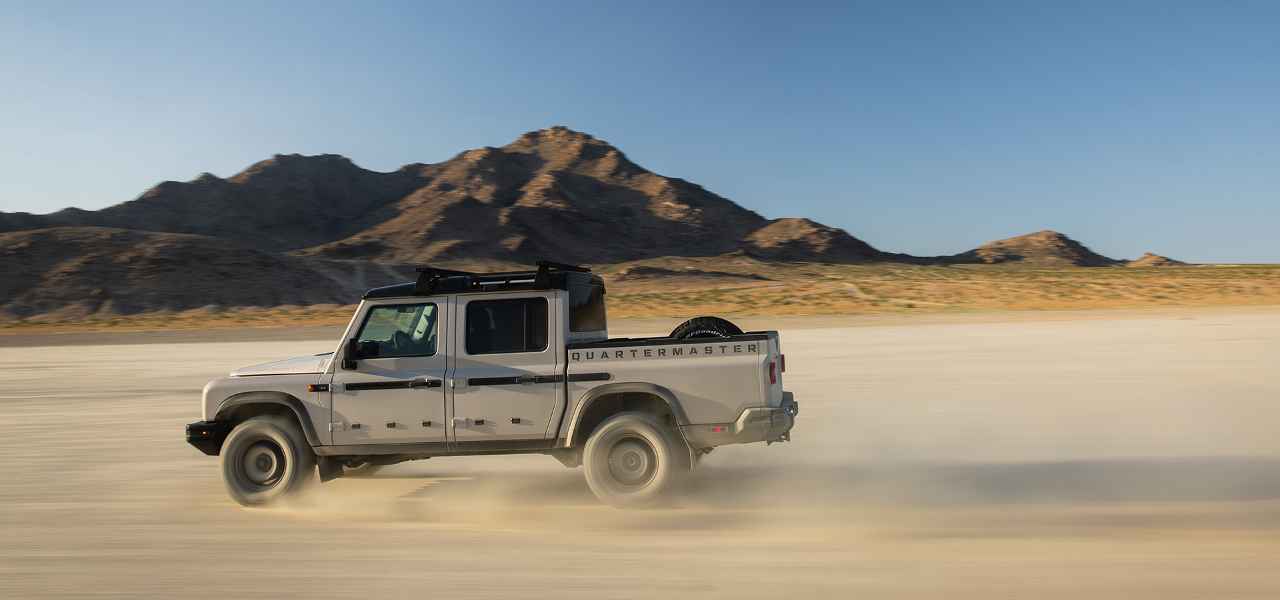 英力士Quartermaster针对越野出行打造,但在沥青路面上的表现略逊一筹。(英力士)
英力士Quartermaster针对越野出行打造,但在沥青路面上的表现略逊一筹。(英力士) 英力士Quartermaster后视图。(英力士)
英力士Quartermaster后视图。(英力士) 英力士Grenadier采用宝马3.0L直列六缸涡轮增压发动机,与动力系统相匹配,充满复古气息。(英力士)
英力士Grenadier采用宝马3.0L直列六缸涡轮增压发动机,与动力系统相匹配,充满复古气息。(英力士)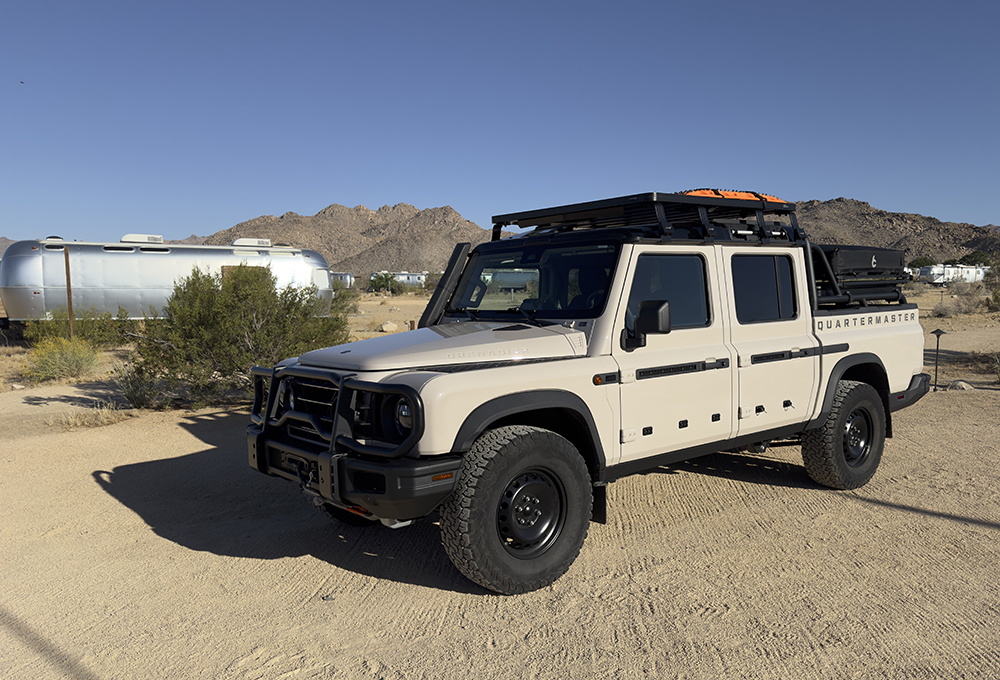 英力士Quartermaster装备齐全,可执行越野任务。(ROBERTO BALDWIN)
英力士Quartermaster装备齐全,可执行越野任务。(ROBERTO BALDWIN) 沙漠中的英力士 Quartermaster。(ROBERTO BALDWIN)
沙漠中的英力士 Quartermaster。(ROBERTO BALDWIN)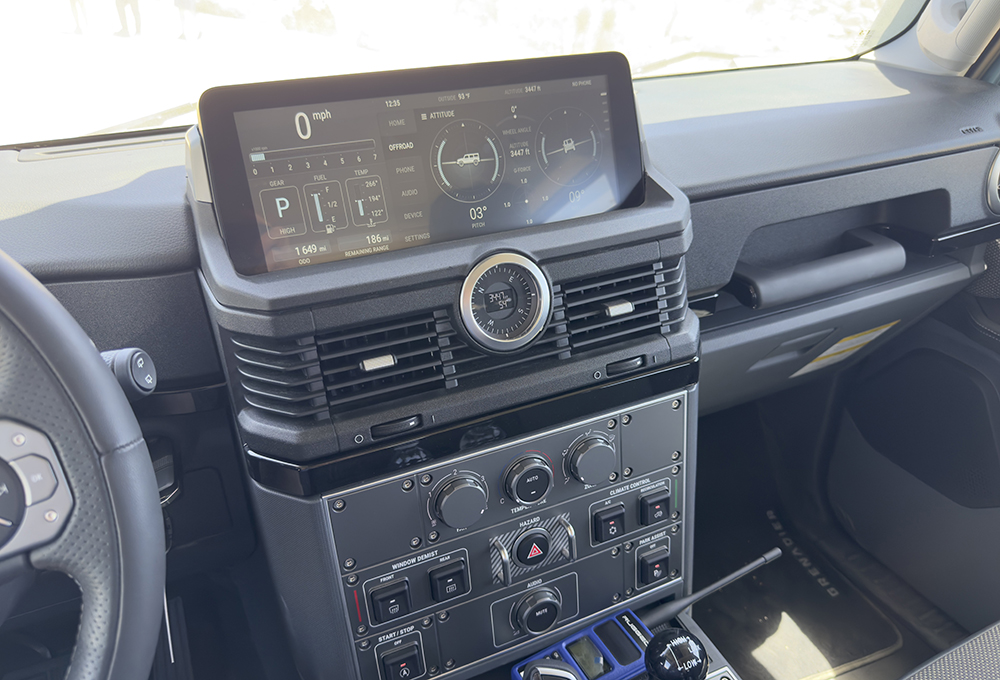 英力士Grenadier的现代装饰之一——数字显示屏,但车内确实以真正的实体按键为主。(ROBERTO BALDWIN)
英力士Grenadier的现代装饰之一——数字显示屏,但车内确实以真正的实体按键为主。(ROBERTO BALDWIN)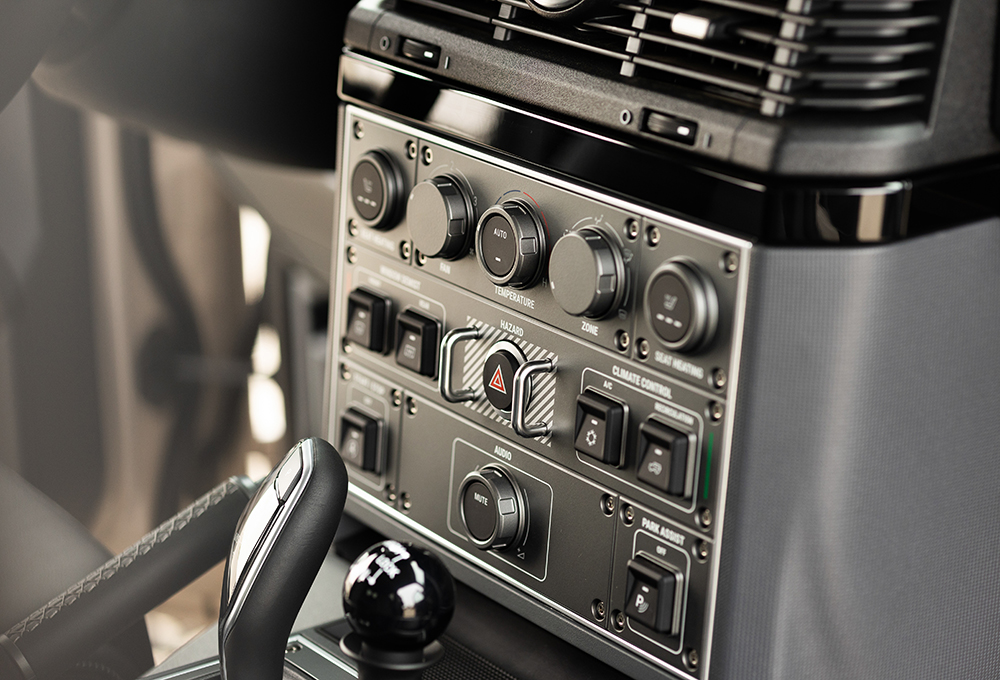 英力士Grenadier的中控按钮。(英力士)
英力士Grenadier的中控按钮。(英力士)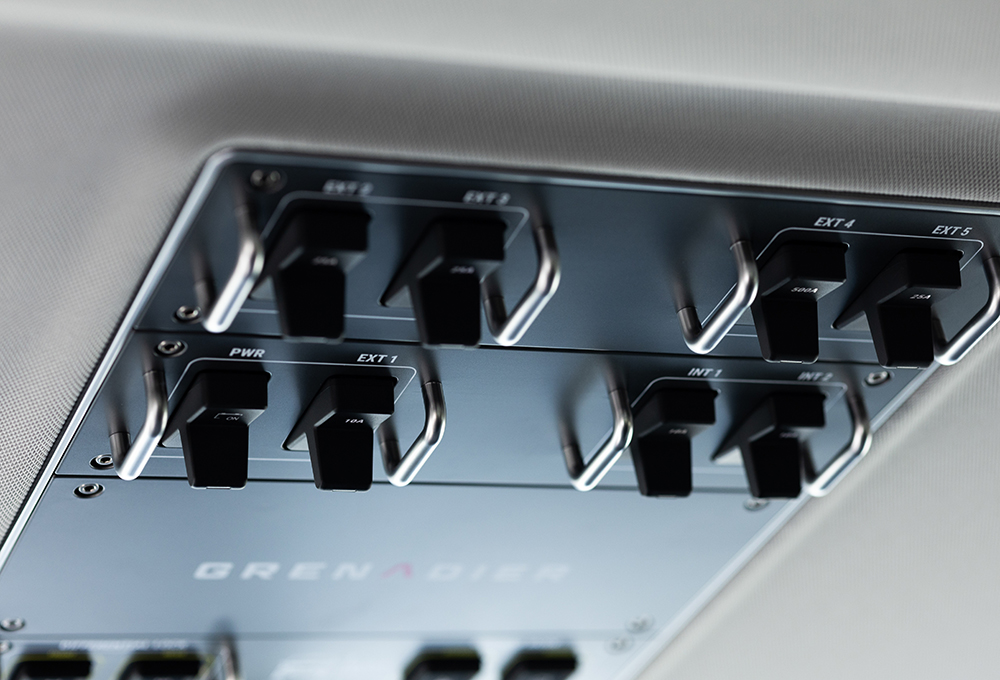 英力士Grenadier的车顶控制开关非常笨重,但是戴着厚厚的手套也能操作。(英力士)
英力士Grenadier的车顶控制开关非常笨重,但是戴着厚厚的手套也能操作。(英力士)
赏心悦目的硬派复古设计。
如今,创立一家新车企,通常意味着其必会在未来四年内推出一款全新的电动跨界车,但英国石化巨头英力士公司选择了另辟蹊径。
英力士打造了复刻7、80年代路虎卫士(Defender)的Grenadier系列,并推出了汽油和柴油两种动力版本,旨在向燃油喷射、触摸屏和倒车摄像头等技术尚未出现的汽车时代致敬。该系列采用了这些现代技术,但外观上仍保留了当时的经典元素。
英力士深知,打造一款现代汽车需要生产诸多部件,并需要投入大量的资金和时间。因此,公司选择从外部采购。例如,Grenadier系列发动机罩下搭载的是宝马的获奖产品B58 3.0L涡轮增压直列六缸发动机,同时撘配与之配套的采埃孚8速自动变速箱。
B58发动机的默认输出功率和扭矩为382hp和369磅英尺(500牛米),Grenadier系列将其分别调整至281hp和331磅英尺。此举旨在满足Grenadier侧重越野性能的设计要求,可利用自动变速箱档把旁的操作杆切换进低速挡。
对于曾经驾驶过70年代、80年代及90年代初期越野车的用户而言,Grenadier系列能够引起其怀旧之情。英力士希望减少车上的电子控制模块(ECM)数量以降低成本,同时希望重现昔日越野车的氛围——实际成果也正如其所愿。在近期的一次试驾过程中,当我驶至岩石遍布的路段上并转入低速挡时(换档杆伴随着一声闷响卡紧的手感,令人无比满足),年轻时似曾相识的驾驶记忆一时涌入我的脑海,我立刻领会了入手Grenadier的意义。
在我亲自试驾之后,我发现这款车在公路上的表现虽然不尽如人意,但也不至于劝退客户。它在乡间小路的表现并不出彩,在高速过弯时更存在局限性,但这款车并非针对高速过弯场景设计,而英力士公司亦对此开诚布公。已购买或预订这款车的爱好者可能已充分权衡了其优缺点。对于那些希望向朋友和社群晒出与众不同的靓车的人来说,他们仅需要准备好迎接全新的驾驶体验即可。
Grenadier的内部体验与外观相得益彰。触摸屏并不负责所有功能的控制,而是主要用于显示速度计、档位、燃油信息、越野行驶状态,以及连接手机播放音乐和使用导航功能等。
当被问及公司对电动车的规划时,Clark表示对业界反感电气化的一些声音不能理解,因为电气化趋势不可阻挡。当然,英力士未来还是会主打能够轻松应对各种地形的怀旧特殊用途汽车,并提供汽油和电动两种动力版本。
Spinning up a new car company in the 2020s typically means there's a new electric crossover being unveiled that may (or may not) come to market sometime in the next four years. British petrochemical company Ineos went in another direction.
The company's petrol and diesel-powered Grenadier lineup resembles the Defenders of the ‘70s and ‘80s. An homage to a time before fuel injection, touchscreens and backup cameras, the Grenadier lineup has all of those features but still looks like something from the time before CDs.
Ineos knew that trying to build many of the elements required to create a modern vehicle would be capital- and time-intensive. So, the company went shopping. Under the hood lies the award-winning B58 BMW 3.0-L turbo inline-six engine, paired with the same ZF 8-speed transmission that BMW uses in its vehicles.
The engine itself has been tuned specifically for the Grenadiers outputting 281 horsepower and 331 pound-feet of torque versus the B58's default 382 hp and 369 lb-ft (500 Nm). This is to match the off-road focus of the vehicle, which uses an actual mechanical shifter next to the BMW-sourced automatic transmission lever to shift the vehicle to lower gearing.
This is where those who have driven off-roaders from the ‘70s, ‘80s, and early ‘90s will enter the nostalgia zone. Ineos wanted to reduce the number of ECMs in the vehicle to reduce cost. The company also wanted to recreate the off-roading vibes of long ago – and has succeeded. As I shifted (more like crammed with a satisfying thud) the vehicle into low ahead of some rock crawling during a recent test drive, memories of doing the same thing in my youth flooded back, and I immediately understood why someone would purchase a Grenadier.
On a triple-digit day on a dusty trail in Joshua Tree, I drove both the Quartermaster pickup and Grenadier Station Wagon. While from a new company, both felt extremely capable of tackling the rocks, ruts, and sand of the desert course. With a locking center differential and optional front and rear locking differentials, the vehicles were never overwhelmed by the terrain. Even during extreme articulation, where I sat shotgun, the off-roader never strained. I complained about the lack of drama to the driver who then descended "quicker than normal" to appease my need for excitement.
One of the more interesting decisions Ineos made was to use a recirculating ball instead of the more common rack-and-pinion steering. The reasoning is fair. Recirculating ball technology is more robust and less likely to be damaged during difficult off-road sessions. It also allows for a more incremental steering experience while tackling the environment. There's also the benefit that the steering is less likely to snap back while on rough terrain.
Frequent off-roaders typically keep their thumbs out of the inside of the steering wheel to reduce the chances of their thumbs being injured when a snap-back occurs. Because the Grenadiers' steering ratio is so high, this is less of an issue. It all sounds great, but…
On asphalt, this design could present a problem for some potential owners. Both vehicles experience quite a lot of play in the steering. There's also a lack of self-centering. It's a feature, not a bug. But for those coming out of, say, a new Land Rover or Toyota, it's an entirely different steering experience. Greg Clark, executive vice president of Ineos Automotive, told SAE Media that new customers often require a bit of a learning curve to adjust. After about 20 minutes, new owners typically become accustomed to the difference, Clark said.
In my time behind the wheel, I found it to be not great on-road but also not a deal breaker. It'll never be a back-roads carving machine. On tight corners at high speed, well, this is not the vehicle for high-speed cornering. Ineos is upfront about this. Enthusiasts who have purchased or pre-ordered the vehicle likely understand the tradeoff. Those looking for something different to impress friends and their community will just have to prepare themselves for a new experience.
The interior experience mirrors the exterior. Instead of the touchscreen taking care of all features, it's mostly there for the speedometer, gear and fuel information, off-roading attitude details and connecting your phone to handle music and navigation.
Large, satisfying-to-push buttons below the screen handle volume control, climate adjustments (including defrost) and even parking assistance. On the ceiling you’ll find controls for differential locks and a series of aux switches for lights, winches, or whatever else an owner wants to install and power on the vehicles. Again, these are all controlled by large buttons. Besides the aesthetic appeal, there’s value for those who live in colder climates as these can be operated while wearing heavy gloves.
While Ineos is a bit of an outlier bringing an ICE vehicle to market while other startups are going all-in on EVs, there is electrification in its future. The Fusilier is slated to land in 2027 as a BEV or a series hybrid. Ineos has been mum on most of the details about the vehicle, but it'll be interesting to see if the interior continues with the automaker's analog-centric aesthetic.
When asked about the electric future, Clark said he was confused by some of the hatred directed towards the powertrain and said that electrification is inevitable. Of course, for Ineos, the future is wrapped in nostalgia and purpose-built vehicles powered by both gasoline and electrons that are ready to tackle terrain with ease.
等级
打分
- 2分
- 4分
- 6分
- 8分
- 10分
平均分
- 作者:ROBERTO BALDWIN
- 行业:汽车
- 主题:内饰,客舱和驾驶舱管理与产品开发制造动力与推进力质量、可靠性与耐久性车身/机身与架构车辆底盘与飞机起落架工程设计与造型测试与检验
